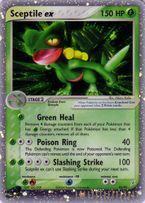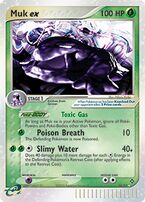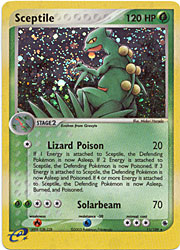Sceptile/Muk (TCG)
| Sceptile/Muk | ||||||||||
|---|---|---|---|---|---|---|---|---|---|---|
| ||||||||||
Sceptile/Muk was a Pokémon Trading Card Game deck archetype that saw moderate success during the 2003-2004 season, though it had largely fallen out of favor by the 2004 World Championships, due in part to its relatively poor matchups against Blaziken-based decks and Gardevoir ex-based decks (such as RAMBO and Gardevoir/Magneton/Delcatty, respectively).
Strategy
Depending on the opponent's deck and the state of the field, Sceptile/Muk focused either on 1) locking down opposing Poké-POWERS and Poké-BODIES with Muk ex's Toxic Gas or 2) attacking the opponent with Sceptile ex while using a combination of the non-ex Sceptile's Energy Trans and Pokémon Nurse to prevent it from being Knocked Out. Many decks of the era relied heavily on Poké-POWERS and Poké-BODIES, so Toxic Gas could greatly hamper an opponent's strategy. Muk ex, though a mediocre attacker on its own, could provide enough of a hindrance to buy time for the user to set up Sceptile ex on the Bench. Because Toxic Gas only functioned while Muk ex was Active, the Sceptile/Muk player could elect to move Muk ex to the Bench should he or she wish to use Energy Trans. Sceptile/Muk decks typically played a high count of switching cards such as Switch and Warp Point to maximize the deck's ability to move Muk ex to and from the Active position at will.
Switch and Warp Point also supported Sceptile ex, the deck's main attacker. By using a combination of one of these Trainer cards and retreating, the player could use Sceptile ex's Slashing Strike (which did 100 damage, enough to knock out most non-ex and Basic ex Pokémon of the era) on consecutive turns. Sceptile ex's other two attacks, Green Heal (which heals 40 damage from each of the user's Pokémon with ![]() attached) and Poison Ring (which does 40 damage and prevents the targeted Pokémon from retreating) also make good use of Switch and Warp Point. Switching between attackers can allow for more healing with Green Heal, and Warp Point can potentially force the opponent to promote an undesirable Pokémon which can then be locked in the Active position with Poison Ring.
attached) and Poison Ring (which does 40 damage and prevents the targeted Pokémon from retreating) also make good use of Switch and Warp Point. Switching between attackers can allow for more healing with Green Heal, and Warp Point can potentially force the opponent to promote an undesirable Pokémon which can then be locked in the Active position with Poison Ring.
Sceptile/Muk's consistency engine was slightly different than most decks of the era in that it did not rely on Dunsparce in the early game. Because it utilized exclusively Grass-type Pokémon, Wurmple was a better option. Wurmple's Call for Friends attack could fill up the user's Bench, while Dunsparce's Strike and Run searched out only three Basic Pokémon. The Supporter cards used were a hodgepodge of drawing Supporters, combined with Professor Elm's Training Method (as the deck relied so heavily on Evolution cards and Oracle. Though Sceptile/Muk could not abuse Oracle to the same degree as a deck that ran Trainer- or Poké-POWER-based draw such as Delcatty, it was still useful in preparing for the following turn. The only semi-common card that would negate this strategy was Desert Shaman, which was played relatively sparingly compared to hand disruption cards of later eras such as N and Judge.
Key cards
- Sceptile ex - With three attacks, Sceptile ex was quite versatile: Green Heal was useful for healing damaged Pokémon, Poison Ring did moderate damage and prevented the opponent from retreating, and Slashing Strike was capable of Knocking Out many opposing Pokémon in one hit. With 150HP, Sceptile ex could withstand at least one attack from most Pokémon, giving the option to heal it with Green Heal or Pokémon Nurse. It also resisted Water-type Pokémon, giving it an advantageous matchup against decks such as Wailord/Fossils and Walrein/Milotic. However, its Weakness to Fire-type Pokémon made it near-worthless against Blaziken-based decks, which were very popular at the time.
- Sceptile - The non-ex Sceptile was not a particularly strong attacker, but its Energy Trans Poké-POWER (along with the obvious fact that it utilized the same evolution line as Sceptile ex) justified its inclusion in the deck. The Energy movement effect Sceptile provided was useful for switching between attackers and negating the downside of Pokémon Nurse.
- Muk ex - Muk ex provided the deck a secondary strategy alongside the attacking/healing strategy provided by the Sceptile line. Its Toxic Gas Poké-BODY was capable of shutting down many decks that relied on Poké-POWERS and Poké-BODIES; even relatively poor matchups like RAMBO struggled when deprived of Delcatty's Energy Draw and Blaziken's Firestarter. Though not a particularly strong attacker in a vacuum, Muk ex's moderate damage output combined with Toxic Gas was enough to overrun some decks, or at least provide the Sceptile/Muk player with enough time to set up Sceptile ex and Sceptile.
- Wurmple - Wurmple was the deck's ideal starter; it could fill the user's Bench with Grass-type Pokémon for one Energy with its Call for Friends attack.
- Pokémon Nurse - Pokémon Nurse provided an identical effect to Max Potion, a heavily played card in more recent years, though in Supporter form. It healed all damage from one of the user's Pokémon, but discarded all Energy attached to said Pokémon. Combined with Energy Trans, the latter effect could be avoided.
- Rare Candy - Rare Candy was used to accelerate the deck's ability to get Sceptile and Sceptile ex into play.
- Switch and Warp Point - Switch and Warp Point were useful for a variety of reasons: switching a Muk ex out of the Active position to use Energy Trans; moving damaged attackers to the Bench to heal with Green Heal; using Slashing Strike multiple turns in a row; and forcing the opponent to promote an undesirable Pokémon to lock active with Poison Ring.
Typical decklist
The deck list appearing below is not official; it is meant to represent an average build of the archetype, not specifically constructed for any regional metagame. Being that this is merely an archetype, a player may wish to change any part of this deck when building his or her own version. The list shown assumes an Expedition through EX Hidden Legends format. Potential later additions may be listed in the Possible tech cards section.
| Quantity | Card | Type | Rarity |
|---|---|---|---|
| 2× | Sceptile ex | ||
| 2× | Sceptile | ||
| 2× | Grovyle | ||
| 4× | Treecko | ||
| 2× | Muk ex | ||
| 3× | Grimer | ||
| 4× | Wurmple | ||
| 3× | Professor Oak's Research | Su | |
| 3× | TV Reporter | Su | |
| 3× | Steven's Advice | Su | |
| 3× | Professor Elm's Training Method | Su | |
| 2× | Oracle | Su | |
| 2× | Pokémon Nurse | Su | |
| 1× | Town Volunteers | Su | |
| 3× | Rare Candy | T | |
| 2× | Switch | T | |
| 2× | Warp Point | T | |
| 1× | Low Pressure System | St | |
| 2× | Boost Energy | ||
| 14× | Grass Energy | — | |
Possible tech cards
The following cards were sometimes used in Sceptile/Muk in place of certain cards included in the above list.
- Sceptile - This Sceptile was included in some Sceptile/Muk builds as a tertiary attacker. Though its Solarbeam attack was usually prohibitively expensive, Lizard Poison was a low-Energy attack that could be used in a pinch to slow down the opponent by putting his or her Active Pokémon to sleep.
- Marill - An error on some versions of this Marill resulted in it having a Retreat Cost of zero. These versions were ruled "play as printed" (this was one of the last error cards to receive such a ruling). A Basic Pokémon with free retreat was extremely useful to the deck, as it allowed the player to promote Marill after his or her Active Pokémon was Knocked Out (or use Switch or Warp Point to promote it), use Poké-POWERS for a turn, and then retreat into Muk ex to attack.
- Dunsparce - Though Wurmple was capable of searching out more Pokémon onto the user's Bench, Dunsparce was preferred in versions of the deck that utilized Marill (as Wurmple was limited only to Grass-type Pokémon). Additionally, by switching into a different Pokémon after attacking, Dunsparce preserved the Energy it used to attack for later redistribution with Energy Trans.
- Roselia - Roselia's Speed Growth attack, though primarily useful for Energy acceleration early in the game, could also be used to recover from an otherwise crippling knockout later in the game. It was also searchable via Wurmple's Call for Friends attack.
- Copycat - Copycat fulfilled essentially the same shuffle/draw consistency role as Professor Oak's Research; use of either was largely personal preference.
- Pokémon Reversal - Pokémon Reversal, though not in many builds due to space constraints, was used occasionally as a utility card. It served several functions similar to Pokémon Catcher in later years (stalling for time while setting up or finishing off a wounded Pokémon), but was dependent on a coin flip to succeed.
See also
| ||||||||

|
This article is part of Project TCG, a Bulbapedia project that aims to report on every aspect of the Pokémon Trading Card Game. |




